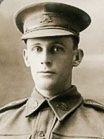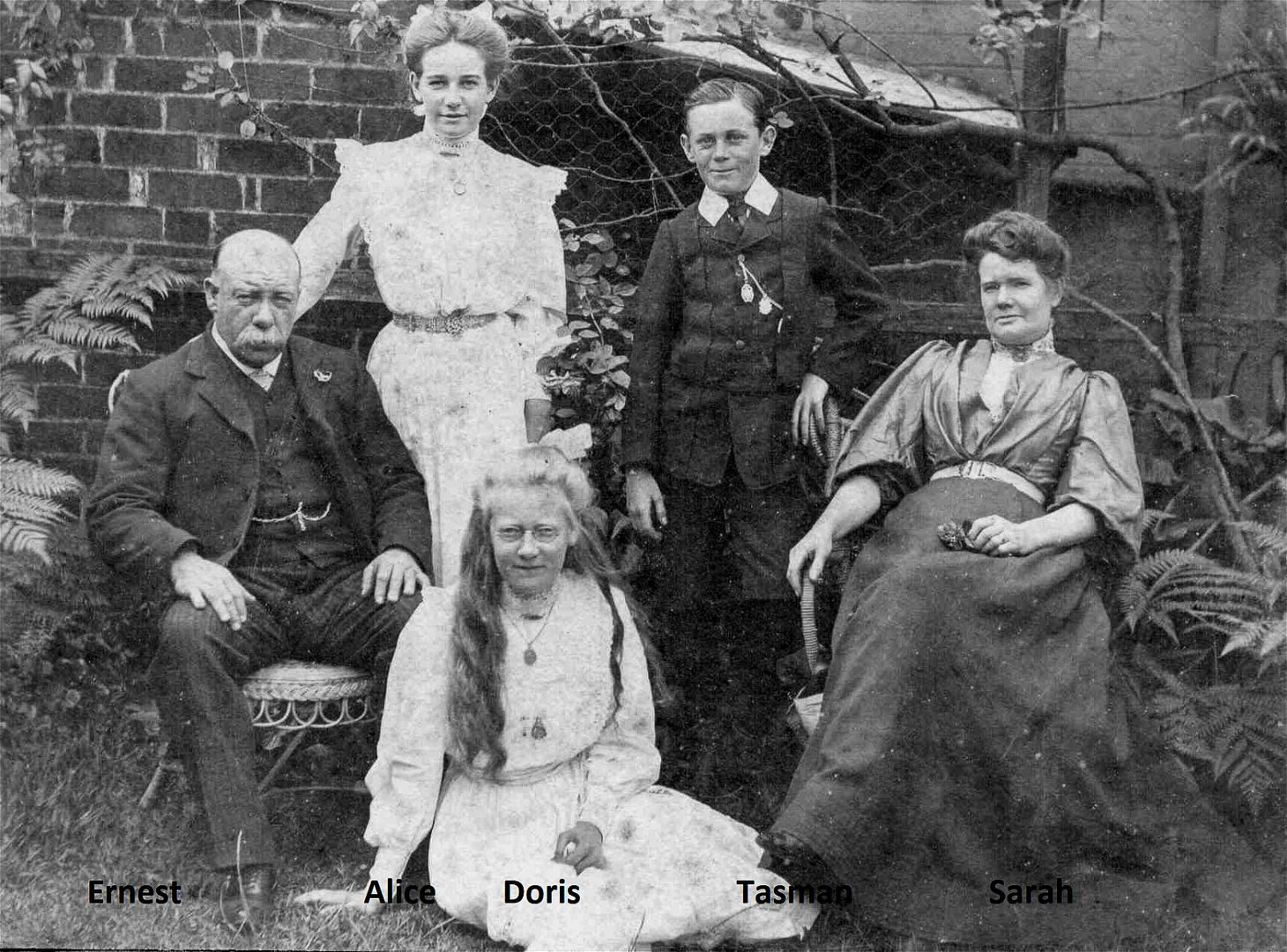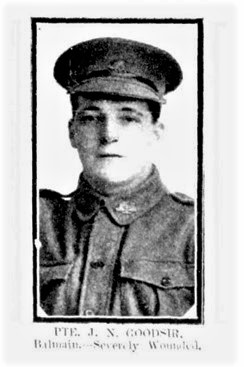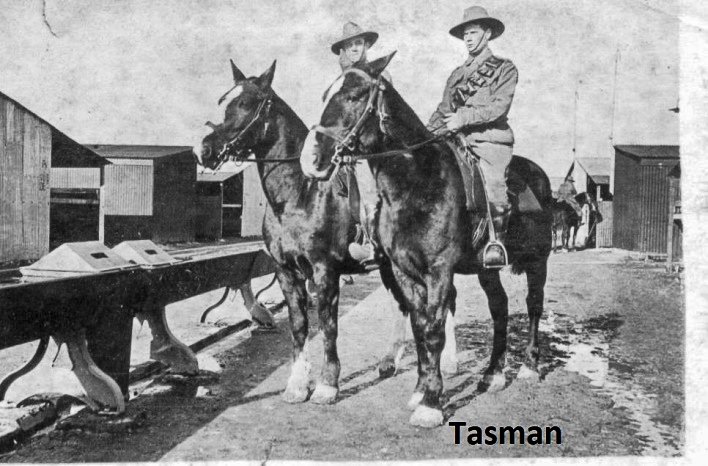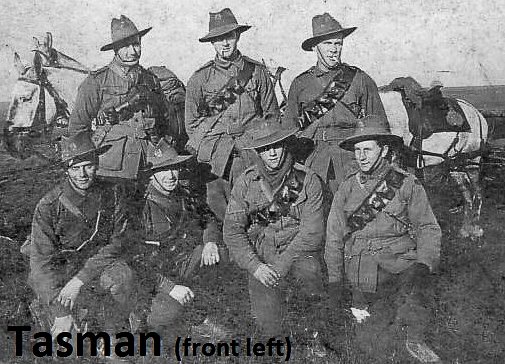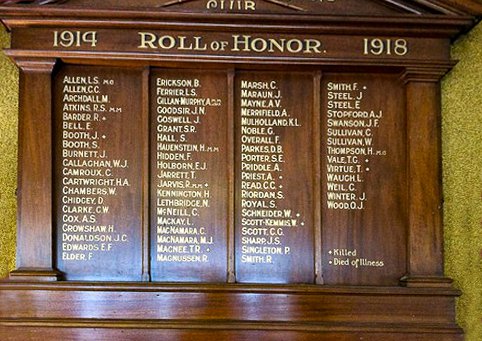Tasman George VALE
Eyes light blue, Hair fair, Complexion fair
Tas plus two
‘Tas plus two’ is a recurring theme throughout the story of the soldier known as Tasman George Vale, formally registered as George Tasman Vale, born on 18 October 1893. Tas, as he was known to family and friends, started life with two older sisters. Alice, born in 1890 and Doris, born in 1892, and two loving parents Ernest Henry Vale and Sarah Jane Vale nee Lynch.
Two more…”You have to be kidding me”
Later it would be two Vale family descendants who would meet for the first time at a Fromelles Association Conference and provide the spark for this story about Tas.
Charles Vale, son of Tas’s first cousin Walter, met John Strickland, grandson of Alice, at the Association Conference in the Hunter Valley on the 27 July 2019. In his words “It was only when I was asked to say why I was there that a voice behind me said, “you have to be kidding me”. It was John. “Neither of us had any idea that we were connected.”
Once again, Tas plus two.
And for a third time - The Two of Us…plus Tas
As Tas enlisted and set off for Europe he went with…who else, but two close mates, Jack Goodsir and Sid Grant. The three mates knew each other through the Balmain Rowing Club. Each was well regarded as oarsmen in the Club’s rowing Eights and Fours, particularly Sid who was an interstate rower. Tas was often in the stroke position of his crews - closest to the stern, mostly responsible for keeping pace for the boat and usually occupied by the most competitive rower in the crew. Newspaper reports of the time show that Tas, Sid and Jack’s crews usually placed well in the Club’s Regattas on Sydney Harbour.

By July 1915, it was reported about the Balmain Club:
“Six more members of the club have joined the Expeditionary Forces. Their names are R. Magnusson (ex-hon. treasurer), J. Goodsir, T. Vale, H. Cartwright, W. Overall, and A. Stopford.”
This was followed by a report one month later when the Balmain Club farewelled those members who had enlisted:
“SOLDIERS' FAREWELL. After the conclusion of the races the Balmain Club embraced the opportunity of saying goodbye to several of their members who have enlisted: R. Magnussen, T. Vale, S. R. Grant, L. S. Allen, J. Goodsir, and H. Cartwright.
C. McNamara (captain), W. J. Furlong (vice captain), J. Chidgey (hon. secretary), O. J. Wood, and W. J. Kolts (hon. secretary and hon. treasurer respectively of the N.S.W. Rowing Association), and E. E. Keary expressed their high appreciation of their patriotic action, and wished them success and a safe return.
The enlistees were held in such esteem that a final farewell was held at the Club. The following report captures the spirit of the times and camaraderie of the Club:
“The farewell function arranged by the members of the Balmain Rowing Club in honor of the members who have enlisted and have not yet left Sydney was a great success. It was held on Tuesday evening last, and was very largely attended. Alderman H. B. Swan, Mayor of Balmain, was in the chair. In proposing the toast of our “Soldier Boys,” he referred with pride to the fact that the club had already 24 members in the Australian Expeditionary Forces, and expressed the hope that he would soon have the pleasure of welcoming them back to Sydney.
……….
The volunteers present were Sergeant L. S. Allen, Drivers M. MacNamara and Stopford, Gunner H. Cartwright, Privates S. R. Grant, J. Goodsir and T. Vale. Sergeant Allen, in responding on their behalf, stated that they were going to help their brother oarsmen who had already left, and hoped that many more would follow their example. When the Allies win, as he confidently expected them to do, he hoped that, if they were fortunate enough to return, the sport of rowing would boom once again.
Mr. Q. L. Deloitte unveiled the honor board containing the names of the members of the Balmain Club who have enlisted. There are 24 names on the board. Well done, Balmain!”
Three Men in a Boat
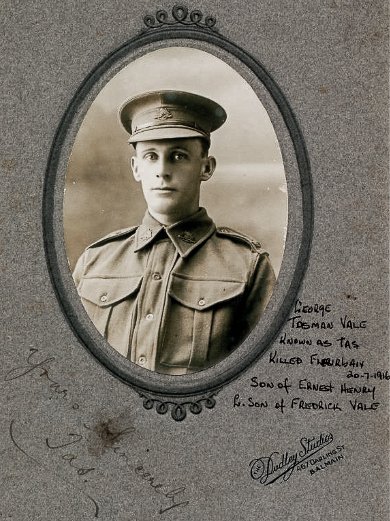
The three Balmain Club oarsmen - Tas, Jack and Sid - joined the 30th Infantry Battalion, C company. According to the AWM, this Battalion had been raised as part of the 8th Brigade at Liverpool in New South Wales on 5 August 1915. Many of its recruits hailed from the Newcastle region and other parts of country New South Wales, and almost an entire company was composed of former RAN ratings from Victoria. The 8th Brigade joined the newly raised 5th Australian Division in Egypt and later proceeded to France, destined for the Western Front, in June 1916.
The three mates’ journey to Egypt can be followed through letters sent back to the Balmain Rowing Club and subsequently published in newspapers:
“Private Jack Goodsir has written the following letter to Mr. Neil MacNamara, captain of the Balmain Rowing Club.
Sid. Grant, Tas.Vale, and myself are doing all right. We are having the time of our lives aboard ship, and getting as fat as pigs. I think I've put on a stone……. We are being treated like lords. The officers are the best, and likewise the food. We have a swimming bath on board, and don't the Balmain boys enjoy it.
I suppose by the time you get this we will be right in the thick of it, and we will try to make a good name for the Balmain Rowing Club. Remember me to all the boys.”
While Jack may have been putting a good shine on their trip to Egypt, Sid wasn’t so sure.
“Mr. Sid Grant, the well-known Interstate oarsmen, has written the following letter to Mr. O. J. Wood, hon. secretary of the New South Wales Rowing Association.
We are having a long and weary journey, calling nowhere. The first week the sea was very rough, and the consequence was that Tas.Vale and myself suffered from mal-de-mer the former being ill for about a fortnight. I had a week of it with hardly a bite to eat all the time.
The time-honored function which is usually held crossing the Equator was duly carried out. The usual pranks and jokes were played, and altogether it was very enjoyable.
Jack Goodsir is the same old 3 and 4 pence, and is as hard as nails.
I will be spending Christmas under very different conditions this year, perhaps in the trenches, but at any rate it's all in the game.
I suppose the old club is just the same. I came across one of the Church of England Grammar School boys on board. He said he rowed in the winning crew in 1913. We had a grand chat over old times, which I enjoyed very much.
I will close with hearty good wishes to yourself and all the Balmanites.”
Sounds like all that rowing on the protected waters of Sydney Harbour hadn’t prepared Tas for bumpier conditions outside the Heads.
Up the Canal without an Oar
One month later, Sid provided an update, reporting that Tas had received a promotion:
“Mr. O. J. Wood has received the following interesting letter from Mr. Sid Grant, the well-known Interstate oarsmen. It is dated December 25, and written from Suez Canal:
We have just come off duty after spending all night in the trenches amid rain and cold. We have overcoats, head and neck mufflers, and gloves. Early next week we will be off out into the desert. I believe it is dangerous country; in fact, where we are now is not too safe. We arrived at Suez on about the 8th of this month, then we were moved to a place just outside Heliopolis. We were there for a week and then packed up suddenly for our present address on the bank of the Suez Canal.
. . . Jack Goodsir is A1; in fact, he holds the floor of the tent at present, and is a regular hard case. Tas Vale has been made a lance-corporal.
I will close with hearty good wishes to all the rowing boys.”
Records show that Tas was promoted to lance corporal on 16 November 1915. He was temporarily promoted to corporal in March 1916 and then confirmed in this rank in early April 1916. His experience of leading rowing crews seems to have translated into leadership in the field.
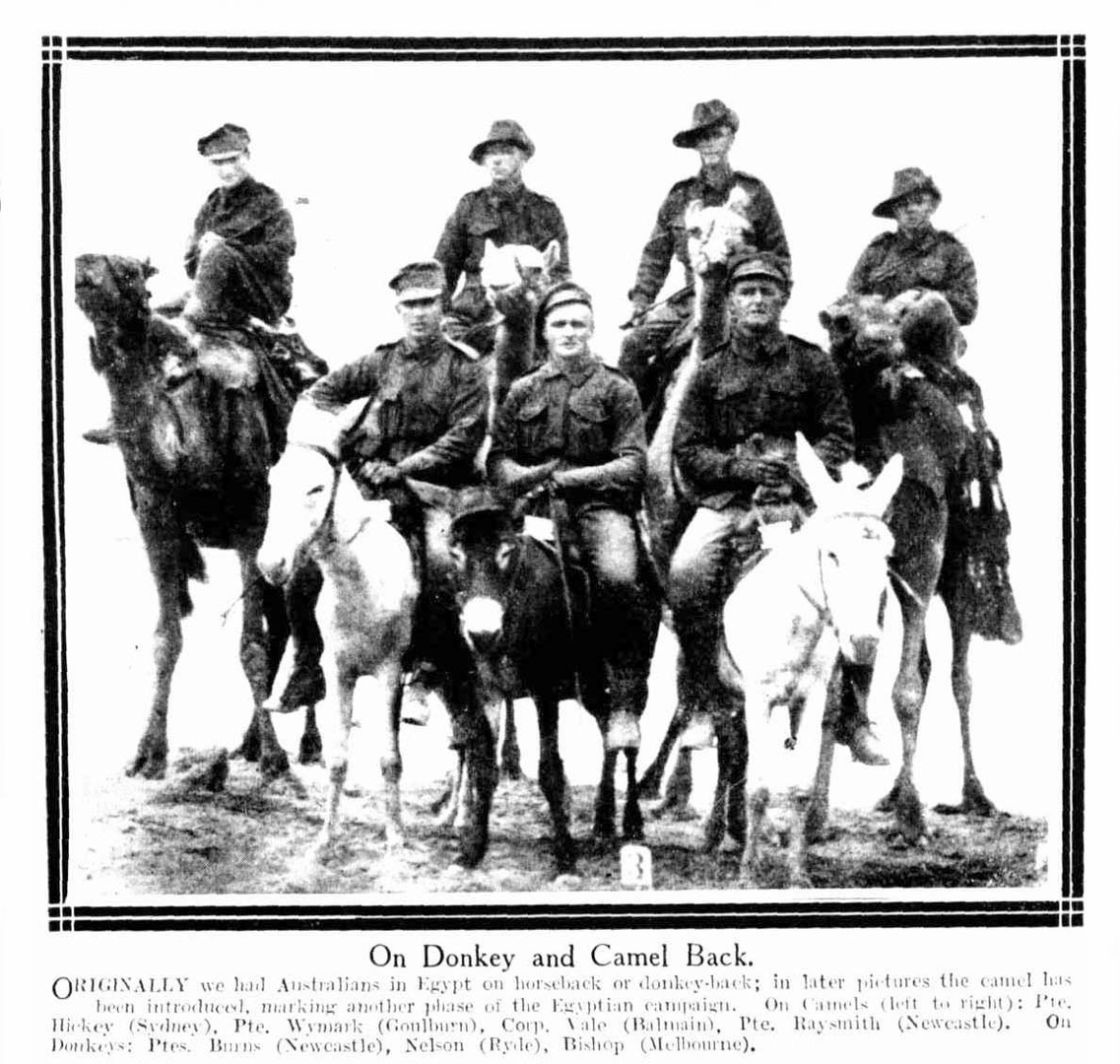
Also in the picture above, centre front row on the donkey, is Henry Oscar Nelson, a soldier from Ryde whose was also killied in action, whom we are also still seeking information.
Tale of Two Cities – Alexandria to Marseilles
On 16 June 1916, Sid, Tas and Jack boarded the HMAT Hororata at Alexandria. One week later on 23 June 1916 the three mates disembarked at Marseilles.
Although disembarking in Marseilles, C Company was not destined to linger. As Lieutenant Colonel H. Sloan wrote in later years of 30th Battalion’s arrival, all but A Company was marched onto a train heading north to the battlefields:
“…women and children, that lined the streets as we marched behind our band to the railway station, whose colour, dress, and characteristics generally reminded us of our homes in far away Australia, compensated to some extent for our inability to remain and avail ourselves of their obvious hospitality.
While few of us could understand their language, there was no mistaking the fervour of their "Vive L' Australies" and expressions of goodwill towards us…
Our train was a long one, consisting of 31 carriages, and after what seemed an interminable wait, we moved slowly out of the station, through a tunnel into the darkness and commenced our long journey through the heart of France…
It is no exaggeration to state that we were almost dumbfounded at the beautiful ever changing panoramas that were unfolded before us…
As the sun rose the exclamations of delight increased; window seats were much in demand from which to view the countryside, every foot of which appeared to be carrying its wealth of wheat, peas, beans, etc. The red-roofed cottages were models of neatness and each seemed to be surrounded by vegetable and flower patches…
Travelling almost due north… we obtained a glimpse of the Eiffel Tower, and the park lands surrounding the Palace of Versailles, down the Valley of the Seine to Rouen, thence north east to Amiens, across the Somme (which later was destined to be the graveyard of so many Australians)… on to Stonier and our destination Hazebrouck, an important town a few miles from the Belgian border and the English Channel. Although a cold rain greeted us on detraining, we were glad to exercise our cramped limbs after a continuous journey of three nights and two days.”
Of course, Hazebrouck is also only a few miles from Fromelles, the site of the 30th Battalion’s first major battle. Their task was initially to provide carrying parties for supplies and ammunition, but they were soon drawn into the fighting.
Family and friends miss Tas
At first, Tas was listed as missing in action on 20 July 1916 after participating in the Battle of Fromelles. His family was accordingly notified.
On 8 September 1916 in a letter to Base Records (page 43, AIF file), George Houghton-Dew of North Sydney enquired as to whether the T. G. Vale posted as missing in either the 200th or 201st list was his friend. Here, the Sydney Harbour connections come to the fore again. Whilst the direct connection between the enquirer and Tas is unknown, it is likely to have been through the Sydney boating community as Mr Dew was a well-known sailing umpire at the Sydney Flying Squadron sailing club at Kirribilli.
Further enquiries regarding Tas’s fate were made in November 1916. Tas’s brother-in-law, Douglas Cowell, of Campsie - husband of Tas’s sister Doris - wrote to Base Records for further information:
“We have had several letters from boys at the front stating that he has been killed; it seems to be the prevalent opinion & naturally the mother is very much upset and worried but we comfort her with the assurance that if these chaps know, surely the department must know. Would it be possible for the Officer in charge of this particular unit in France not to know if he had been killed & the men to know? Would you kindly look into the matter again? This boy was the only son & they are fearfully worried…”
Base records replied (page 39, AIF file) that no further report of Tas’s fate had been received but they would make further investigations if Mr Cowell would forward any reliable sources of information received by the family.
Indeed, Tas’s family’s need for information is reflected in a newspaper advertisement a month later.
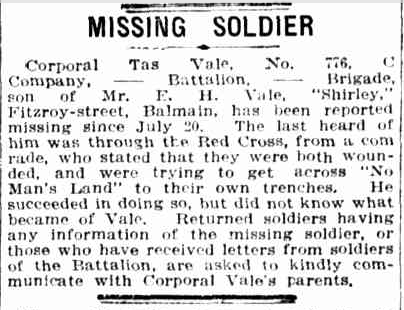
Given the date, 27 December 1916, the family must have had a very sad Christmas without Tas.
All that Remains
The chaos of the aftermath of Fromelles resulted in hundreds of young Australians disappearing without trace, and the administrative systems of the AIF weren’t really prepared for casualties on such a huge scale. It wasn’t until August of the following year that the 30th Battalion had the time and resources to conduct a Court of Enquiry into its missing, which concluded - in the absence of any other information - that they had all been killed in action.
In July 1917, the family received Tas’s personal effects. In an AIF kit store report these items were listed as: pencil case, metal key chain, match box, whistle, wrist watch (damaged), razor in case, wrist watch strap, fountain pen (damaged), two rising sun badges, aluminium drinking cup, cotton bag:
When leaving Australia, each soldier had a kit bag containing all of the officially authorised equipment and any small personal items they may have wanted for their service. There was also a more modest sea kit bag containing all of the items required for the long voyage to Egypt, England or France. This included PT gear, razor, towel, toiletries, etc and allowed the larger kit bags to be stored in the hold of the transport ship, and not retrieved until the final destination was reached.
After disembarkation, soldiers sorted their kit, selecting the items needed for immediate service to be carried on their persons. Since it was summer in France when the 30th Battalion arrived, the men didn’t need extra blankets or greatcoats. They would have taken a change of underclothing (shirt and underpants) spare socks, razor, towel and toiletries, housewife (needles, thread, buttons, etc for minor sewing repairs) waterproof groundsheet, writing materials, mess tins and cutlery. Some would have carried a spare pair of boots, although it added weight, and most would have had at least one blanket, since even in summer, France isn’t always warm!
Many would have carried reading matter in the form of a small book, often the Bible, and many also took a small candlestick or holder. Matches, cigarettes, pipes, tobacco, etc were at the individual’s discretion, but pretty much everybody had them. All of this paraphernalia would fit into the soldier’s large backpack and small haversack. Obviously, the less you carried, the less weight you were burdened with, given that you had to carry your own rifle and ammunition.
What happened to all their extra items? If not needed in the short to medium term, they were packed back into the soldier’s kit bag and sent off into storage, generally in the UK, where the AIF’s Kit Store in London held them until needed. Soldiers on leave in England could call and collect items required, (and add extra objects such as souvenirs) or their units could order that certain required items be recovered and sent out in bulk.
When a soldier was reported as having been killed, and a next-of-kin identified, his kit bag would be recovered from store and opened. Items of Government property (which included uniforms and blankets) would be recycled into the system for reissue, but anything identified as being personal property would be sent to the next-of-kin. The inventory list from Tas’s kit seems fairly typical for a soldier who had served for a while, but hadn’t seen much front line service. Although spare Rising Sun badges were technically Government property, these items were generally considered appropriate to be given to families as keepsakes.
…. Soldiers were generally reluctant to throw things away, so Tasman was typical in having kept a damaged pen and watch. He may have thought that they could be repaired later, or they may have been gifts from loved ones which he was unwilling to part with. In either case, rather than keep them on his person, he had stored them in his kit bag. The razor may also have been damaged, blunt or a spare, and the other items were things he wanted to keep but didn’t need to drag around the trenches with him.
As foreshadowed, on 23 July 1917 Tas’s status was changed from “Missing” to “Killed in Action, 20 July 1916” by pronouncement of a Court of Enquiry.
Not satisfied with this outcome, Tas’s mother Sarah immediately wrote to Base Records seeking further information as to how the Court of Enquiry identified her son as killed. She signed off “We are anxiously awaiting your reply”. Sadly, their response was that they had no further information beyond the final finding of the enquiry sent to them by cable.
Finding answers through the Red Cross
It is likely however, that the family received information direct from soldiers who served with Tas or via the Red Cross. The answers to some of Sarah’s enquiries can be found within the Red Cross files.
650 Sergeant Albert H. ELLIS, C Company, 30th Bn, 24 August 1916
“I saw him wounded in the head at Fleurbaix in the charge on July 19th. His wound did not appear very serious. One of his mates bandaged it with his field dressing. This occurred about halfway across to the German lines. I did not see him again.”
1317 Pte Ernest J. SAVELL, C Company, 30th Bn, 28 August 1916
“I saw him badly wounded and bleeding freely from the face, sitting down on the left of a crater which had been exploded in the middle of No Man’s Land. This was about an hour after the beginning of the attack on 19.7.16. He had been over to the German trenches, was there wounded and was on his way back when I saw him. I spoke to him and though he seemed badly wounded he said he was all right. I was advancing at the time and had to leave him. We did not retire till the next day. He seemed very exhausted and was saturated with blood.”
617 Lance Corporal James R. BISHOP, 30th Bn (patient, 1st London General Hospital, Camberwell, England), 24 November 1916
“Informant states that on the 19th July at Fleurbaix, informant saw F. (sic) G. Vale in a mine crater with a wound in the shoulder and a scratch on his temple.”
741 Pte Frank W. RAYSMITH, 30th Bn (patient, No 1 Australian General Hospital, Rouen), 8 December 1916
“ In No Man’s Land I saw him wounded by a bayonet in the left shoulder, and a slight head wound. I never heard any more. I shouted to him and he said he was going back. We were retiring at the time and nothing more was ever heard of him.”
[[Source: AWM: Australian Red Cross Wounded and Missing Files - VALE Tasman George pages 3, 4, 5, 7 ]]
Other reports from fellow soldiers were also noted.
691 Pte Albert H JAMES, 30th Bn
“I knew him, and last saw him in Nomensland at Fleurbaix. He was wounded with bayonet in chest, and hit apparently in head with rifle butt. He was badly wounded. That was the night of July 19th–20th.”
148 Cpl Walter A DOWD, 30th Bn
“Note. Pte A.J. BURNS of CX now at Perham Downs convalescing, told me he came back with him on early morning of July 20th. And Vale died beside him on the way back. ”
[[Source: AWM: Australian Red Cross Wounded and Missing Files - VALE Tasman George pages 6 ]]
As can be seen, the evidence was incomplete and certainly not definitive. In the circumstances, this uncertainty was to be expected and not uncommon as the evidence was being given some weeks or even months after the Battle by survivors who were often undergoing treatment for their own injuries. Naturally, their recollections of the tumult of the trenches whilst under fire was always going to be patchy and incomplete.

Remembering Tas
The following year, his old friends at the Balmain Rowing Club paid tribute to Tas and another fallen member by naming a racing skiff after each man:
ROWING - BALMAIN CLUB
The members of the Balmain Rowing Club met at their headquarters yesterday afternoon and named two racing skiffs in memory of two of their comrades, Captain Tom Macnee and Corporal Tas. Vale, who were killed in action. Dr. A. W. Mobbs, president of the club, performed the ceremony.
At about the same time, a memorial was placed in the local Birchgrove church, St John the Evangelist. The oak with which the memorial was made was donated by a Mr Chidgey, another name well known in the Balmain rowing community.
“It was decided in mid-1918 that an honour roll should be placed in the Church to record the names of all the men from the Parish that had served in the forces. The honour roll that surmounts the choir stalls at the right of the sanctuary is superbly carved, with the traditional grape vine design being symbolic of the Eucharist and of life itself. The rich Tasmanian Oak was donated by a parishioner, Mr Chidgey, and the firm of Todd & Co were responsible for the fine workmanship. The honour roll, which cost 120 Pounds, was unveiled at a moving service in August 1918 at which the Archbishop was again present.
The dead march was played, and the last post sounded in memory of the fallen - but the end of the service highlighted the Resurrection from the dead with the singing of the Halleluiah Chorus.”
Tas was also commemorated on the Balmain Rowing Club Roll of Honour and on his father’s gravestone. Sadly, his father Ernest had died on 9 April 1919 at the age of 60.
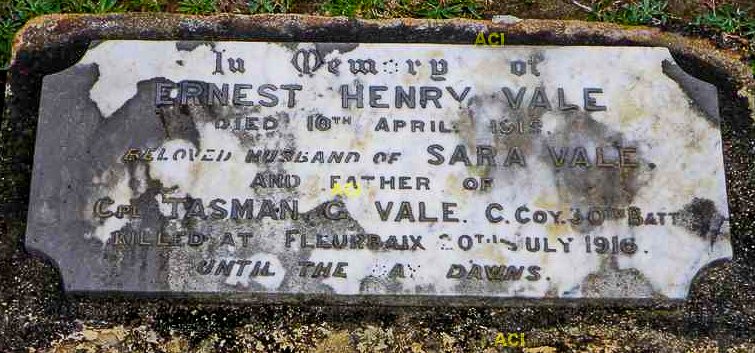
And his two mates
Both of Tas’s rowing mates – Jack Goodsir and Sid Grant – were wounded at Fromelles but, unlike Tas, survived to return home.
Sid Grant was severely wounded at Fromelles suffering shell shock and spinal concussion. He spent some months in English hospitals before being invalided home in early 1917. He resumed work as a plumber, married and had two children. Sid died in March 1951, aged 64.
At Fromelles, Jack suffered severe gunshot wounds and was invalided to England for treatment. He was then attached to AIF Headquarters and promoted to ER Lance-Corporal and then ER Sergeant. In January 1920, Jack Goodsir returned home to Australia. He returned to his pre-war job as a bank clerk, married twice, had two daughters and died in 1955 at the age of 61 years.
Mt DNA is still being sought from family
| Soldier | Tasman George VALE 1893–1916 |
| Parents | Ernest Henry VALE 1859–1919, Balmain, NSW | ||
| Sarah Jane LYNCH b.1863 Tasmania d. 1948 NSW |
| Grandparents | |||
| Paternal | Frederick VALE and Sarah CRANE | ||
| Maternal | George LYNCH and Margaret O’BOYLE |
Note According to family members, the Vale family came from Solihull, Warwickshire in the midlands of England. Frederick Vale, came to Australia about 1853 and married Sarah Crane in St. James Church, Sydney on 2 January 1855. They lived and raised their family in Balmain where he was a publican in a number of local hotels.
Margaret O’BOYLE’s name is recorded variously as Boyle, Bell and Cousins
Seeking DNA Donors

Contacts
(Contact: carla@fromelles.info or geoffrey@fromelles.info).
(Contact: army.uwc@defence.gov.au or phone 1800 019 090).
Donations
If you are able, please contribute to the upkeep of this resource.
(Contact: bill@fromelles.info ).
